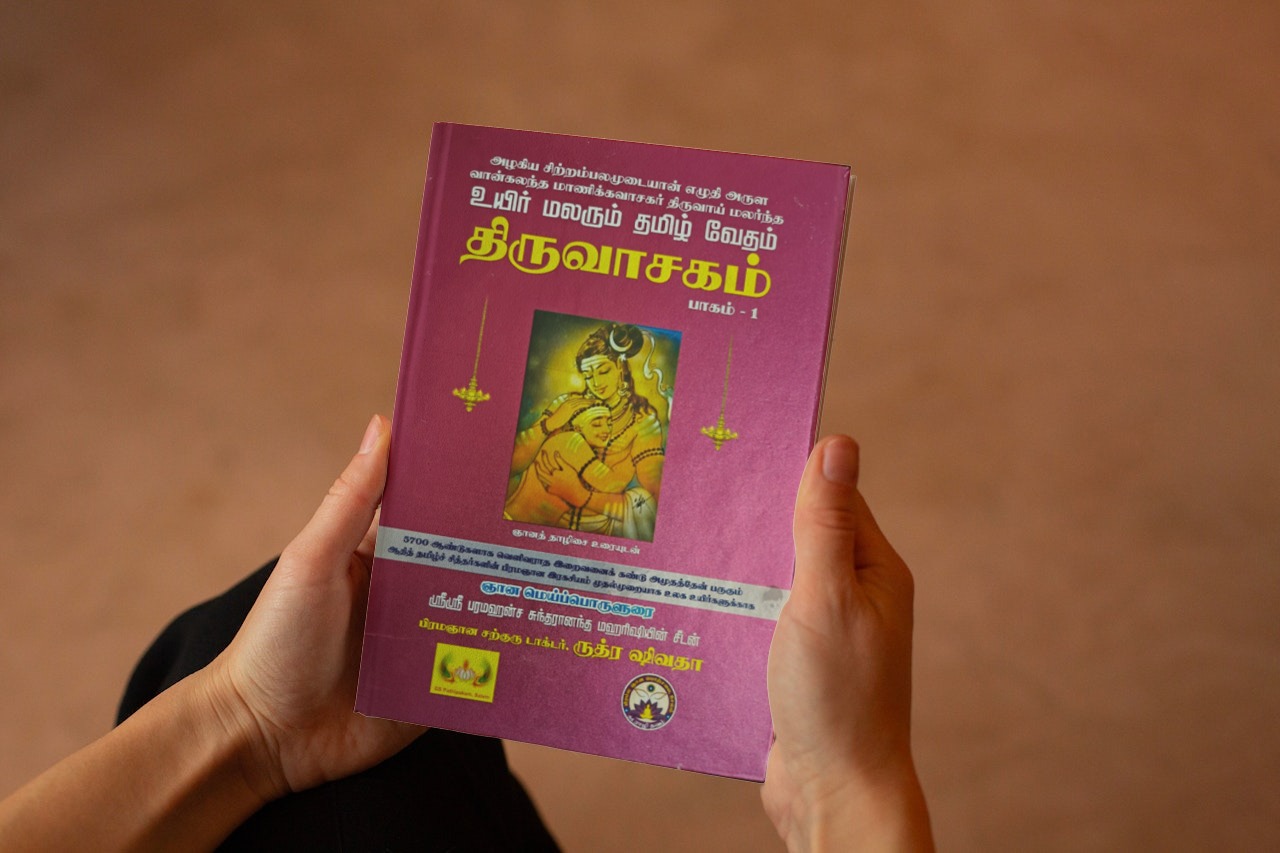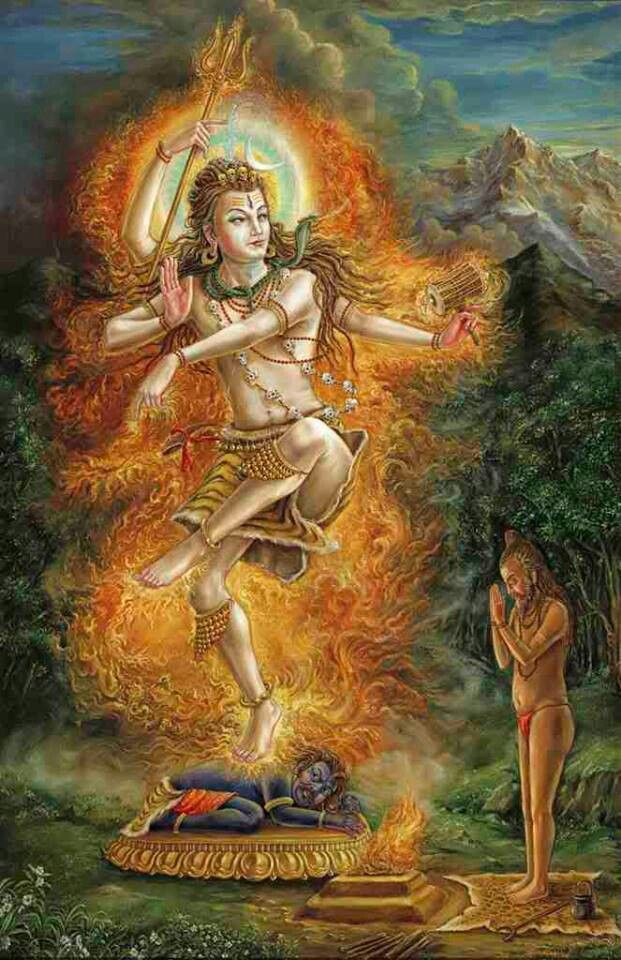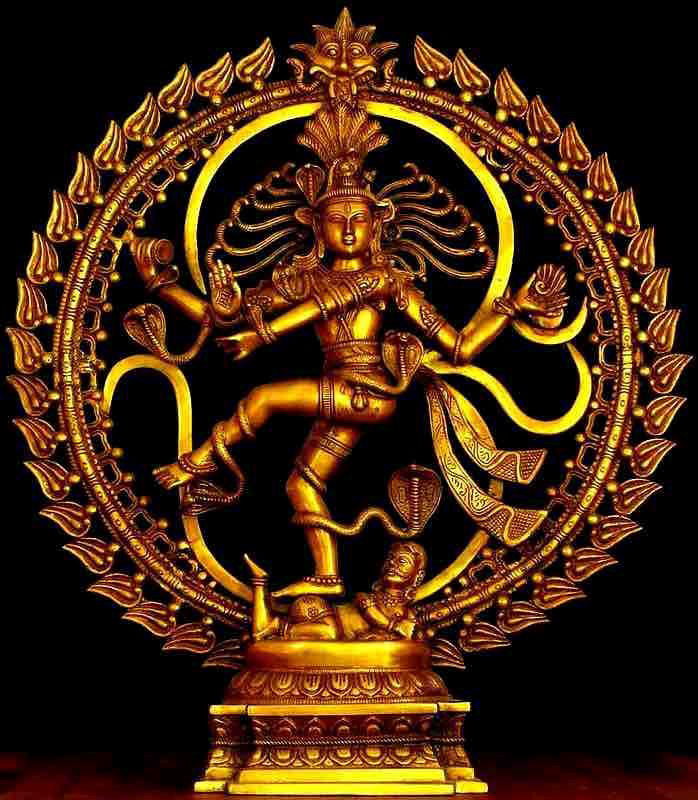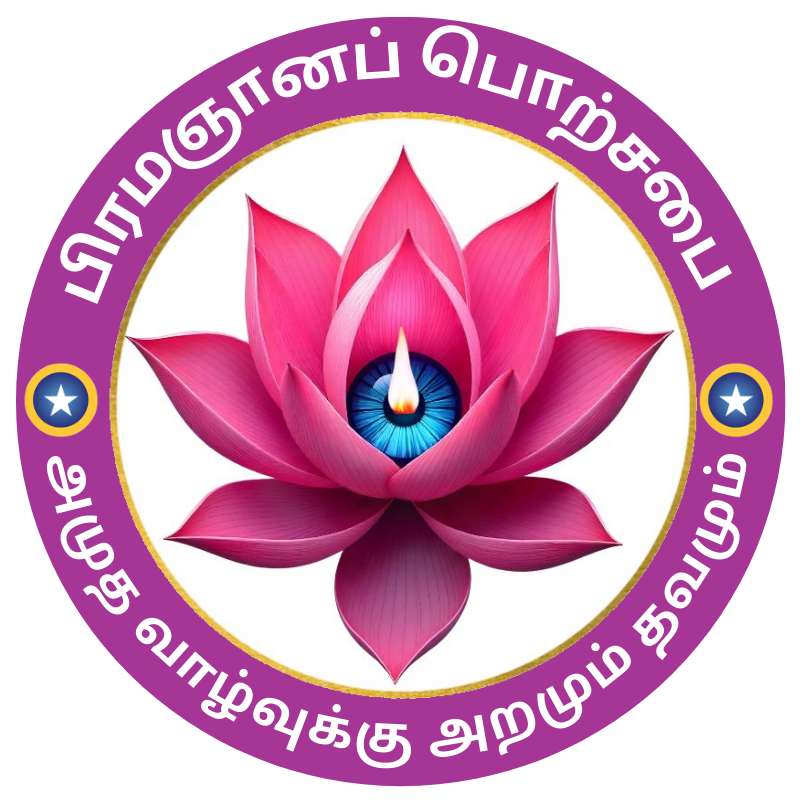What is Thiruvasagam?
What does Thiruvasagam mean?
Understanding the meaning of Thiruvasagam first allows us to fully comprehend its essence. We must initially dissect the word Thiruvasagam. Breaking it down, we have:
‘Thi’ can be split into ‘T + i’, ‘ru’ into ‘R + u’, ‘va’ into ‘V + a’, ‘sa’ into ‘S + a’, ‘ka’ into ‘K + a’, and ‘m’ being a consonant stays as ‘m’. Hence, the word contains 6 consonants and 5 vowels, combining to form Thiruvasagam.
Thiruvasagam encompasses a profound mystical wisdom with its six consonants and five vowels.
The six consonants symbolize three physical aspects on each of the divine feet, respectively, representing our two eyes, revered in mystical and sage traditions as divine feet.
This structure can also denote the six abodes of Lord Muruga in devotional literature, supported by the phrase “the son appeared before the father,” referring to these six elements. In yogic texts, these correspond to the six chakras: Muladhara, Swadhisthana, Manipura, Anahata, Vishuddha, and Ajna, located along the spine from the base to the forehead, the foundational chakras of our body.
The five vowels symbolize the five elements—earth, water, fire, air, and space—which are essential for life in the universe and in humans. Without the energy of these elements, life is unsustainable.

These five elements, while existing separately in the universe and our bodies, come together at a single point, symbolically uniting like the five Pandavas, crafted by the divine into a unified essence in the cosmos and our bodies. If you’re unaware of this focal point, the foundational verse of Sivapuranam in Thiruvasagam, “Namasivaya Vazhga, Nathan Thal Vazhga,” will not resonate with you.
The first verse of Thiruvasagam speaks of the blissful union and location of these five life forces within our body, composed by the exalted Manikkavasagar, a sage in the Saiva tradition who embodies the highest seat of spiritual wisdom through the paths of Righteousness, Action, Yoga, and Knowledge.
Has any other scripture ever conveyed such profound and inexhaustible truths of existence, filled with joy and bliss, as Thiruvasagam? Certainly not. This magnitude and special qualities were so understood by G.U. Pope, who, moved by the work, translated it into English in 1900, giving this treasure of The Tamil Vedham that nurtures and blossoms the essence of the soul to the world.

Six Consonants and Five Vowels
These five vital breaths are situated within the cave of Om in our bodies, under our divine feet. This is where the six truths are also located. Thus, if the six truths and the five vital breaths together converge at one point, what we all must seek to enhance our life force, as sung throughout this Thiruvasagam, is the divine wisdom. Thiruvasagam is not merely a book of devotion. No, it is a nectarous honey that drips vitality.
If we have nurtured devotion without understanding these six truths and five vital breaths, what can be said other than naming it ignorance? The term ‘ignorance’ is not just about stating what we do not know; it directs us towards what we need to understand. How do we call it ignorance if it is about understanding what we do not know? How does it become a word that teaches us? Do you understand this question?
Dissecting a word to find its meaning is a tradition in our Tamil grammar. Similarly, if we dissect ‘ignorance,’ its meaning becomes clear. We could split ignorance as ‘know’ + ‘slow.’ ‘Know’ means to learn, and ‘slow’ represents a creature, the tortoise, which is often used metaphorically for our senses. To control our senses, we are advised to be like the tortoise.
This is what Valluvar said in his 126th couplet of the Thirukkural:
“If one can restrain his five senses like a tortoise withdrawing its limbs into its shell during danger, then such restraint will protect him throughout seven births as if within a fortress.”
The tortoise symbolizes the control of all five senses together, at one point, just as we should also master our senses at a single point.
We must always strive to understand clearly. Until now, the world has taught us only to control our senses separately. If this situation must change immediately, you must cling tightly to the divine feet of the Lord, where all senses converge. Valluvar in his 350th couplet advises:
“Cling to the attachment that is free of all attachments, to learn to detach from attachment.”
Valluvar teaches us to cling without clinging, where lies the secret of divine wisdom. Though attached to the body, there exists a principle of wisdom that remains unattached. If you begin your journey by firmly grasping this principle, you can reach the abode of God.
Have you noticed how profound the word ‘tortoise'(Aamai in Tamil) is in its Gnana Meaning? If we again dissect ‘tortoise,’ it splits into ‘aa’ (vowel) + ‘m’ (consonant) + ‘i’ (indicating two eyes).
The true Tamil meaning of ‘tortoise’ involves the life and truth represented by two eyes, where life and truth meet. Tamil itself embodies wisdom. Tamil is not just a common language but a language of wisdom that continuously nurtures our spirit at every moment.
Receive The Body Of Enlightenment
In verse 349, Thiruvalluvar has subtly communicated a significant divine secret to this world. To our knowledge, no one has explicitly declared the true essence of this couplet.
The verse states:
“For the eye unattached, birth is severed,
All else seen as transient falsehoods.”
This is the verse. Do you understand the meaning it conveys? It suggests that the eye, when free from attachments, can sever the cycle of birth, and everything else appears as transient illusions. The term ‘unattached eye’ refers to a vision devoid of clinginess. Have we ever contemplated whether such an eye physically adheres to our body without any attachment? Not really. This is the secret of divine knowledge. Are the eyes truly unattached, holding onto nothing?
Yet, today’s world has strayed from the wisdom offered by Tamil teachings and continues to live in ignorance. We have crafted this speech to emphasize that humans should no longer dwell in the abode of ignorance. All beings should immerse in the joy of divine experience Shiva, a prayer we daily offer to our Sadhguru.
Why were temples built by our ancestors? What truths do temples convey to us? What message do they share with us? What is the relationship between temples and us, and between temples and God, and between God and us? How are the towers, flagstaffs, sacrificial altars, temple guardians, sanctum sanctorum, the darkness within it, the light of the lamps, and the sculptures of deities in that light relevant? Why do we circumambulate the temple from right to left and not the other way around? Why is the lingam, not a full statue, placed in the sanctum? Why do priests, temple custodians, and Brahmins ring bells with their left hand and perform aarti with their right hand? Do we truly understand the profound meanings behind these practices? Ask yourselves.
To find answers, delve into layered teachings such as those by Agathiyar, the grace-filled Thiruvasagam, and the compositions of Manikkavasagar, Thirugnana Sambandar, Sundarar, Avvaiyar, and Valluvar, similar to the great avatar Babaji and our guru Sundarananda Maharishi. When you thoroughly absorb and feel Thiruvasagam, you too can attain the body of enlightenment.


When and How should Thiruvasagam be Read?
Temples are schools teaching us wisdom, yet we attend unaware of this. Do we understand what the rituals signify? Have we embraced their teachings? Read Thiruvasagam deeply and aloud, ensuring your brain hears your voice. Always maintain two points of focus during your reading, as this reading alone will blossom divine knowledge within you.
Thiruvasagam should be read from 3 to 6 AM.
Why read Thiruvasagam between these hours? Because a magical joy, a blissful illusion, must occur if you desire your soul to flourish. Follow these two practices without fail, and the truth will reveal itself.
Numerous poetic works filled with divine elements exist worldwide. If literary works containing complete wisdom exist, only our life-blooming Tamil Vedham, written by the all-powerful Parameshwara with divine tools, stands as a crown jewel. Thiruvasagam alone encompasses such grandeur. Thiruvalluvar spoke for humans in Thirukkural. God spoke to humans in Bhagavad Gita. But it is in Thiruvasagam that humans sang for God.
No other texts possess the unique glory that through singing, God himself has written, revealing how divine each line and verse must be, overflowing with divine knowledge. This is where we must deeply observe.
How should a text be? It should purify the hearts of readers and learners, providing them with a complete path of wisdom. All verses of Thiruvasagam are sung simply and sweetly with wisdom and ecstatic joy, gradually melting all our senses, dissolving tears, and transcending the mind, intellect, consciousness, and ego to achieve a timeless bliss. Beyond reading or learning any other texts, we must consider whether such a state is attainable from them.
What to discard and what to grasp in this Tamil Vedham, Thiruvasagam? When read devoid of feelings, we become emotionless; when read with love, we fall passionately in love with God; when understood in words, we go beyond words in the mind; when pondered with intellect, we transcend knowledge; when souls seeking an end find it, they achieve endless wisdom; when people suffering in misery find it, they reach heavenly realms; seekers of dawn find the sun; and those living in darkness find an everlasting light. What to say? How to say? These are the great glories and virtues of Thiruvasagam, unsculptable in stone, unsingable in poetry, existing beyond time, space, and contemporary news as a ceaseless river of divine knowledge.
Divine Wisdom
Divine Wisdom, like an ocean, once discovered and integrated into ourselves, seeds a state of waiting for harvest. It flows abundantly in every stanza here, unfailingly.
Breaking down ‘Thiruvasagam‘ into ‘Thiru + Vas(am) + Agam’, we understand it as the divine residing in the soul, the sacred living within us. It reveals how one can see, interact with, love, and joyfully merge with the Divine—Shiva, the ancient essence, the truth—shedding tears of happiness and ultimately becoming one with the Divine Essence.
Here, you are not merely learning Thiruvasagam; you are discovering yourself. You will not just appreciate the beauty and richness of Thiruvasagam. Instead, you will see your own inherent beauty and the richness of life within you. Thiruvasagam is about discovering the place within yourself where you have lost yourself. It teaches how to love the Divine, how to unite with and delight in it. Merging is not a physical event; it is a miraculous convergence of life within life, an experience of joy you are about to understand here.
As you contemplate Thiruvasagam and recite these loving hymns, your heart will continuously be submerged in the divine experience of Shiva, shedding tears continuously, attaining a divine presence. As tears stream, you will melt within yourself, lost in a blissful breeze, beyond the sense of self.

The phrase, “Who before the master of these readings can still open their mouth?” illustrates the grandeur of Thiruvasagam. It can be celebrated as a ‘melodious divine garland cherished by all.’ Sivathiru Maraimalai Adigalar noted, “Thiruvasagam is a reading of unparalleled beauty,” and “Thiru signifies a beauty that is desired upon sight.”
Thiruvasagam, the Tamil Veda that blossoms life, has been revered as a scriptural text among Tamil-speaking populations and devotees of Shaivism in Tamil Nadu and abroad until today. Moving forward, it should evolve into a scripture that blooms the life and souls of those who recite it, as envisioned in its profound essence, revealed with the consent of our Sadhguru. Thiruvasagam is no longer just a traditional text; it stands as a timeless beacon of divine wisdom, a scripture of ecstatic divine joy.
Can a text elevate a soul to a state of realization and blossom it? Undoubtedly, Thiruvasagam can and has demonstrated this. This is why Manikkavasagar was shown pointing at the true essence at the Chidambaram Natarajar temple after completing his recitation, merging his physical body into light with Shiva. What better proof do we need of Thiruvasagam as a treasure of divine wisdom? We respectfully urge scholars to deeply reflect on this.
Thiruvasagam, transcending its role as a mere religious text, is celebrated as a literary treasure, deeply appreciated by Tamil people. A soul, bound in profound darkness, seeking the cosmic light, aiming towards the pinnacle of the primal sound within, experiences various blissful events and true realizations on this journey, as portrayed in these divine verses by Manikkavasagar, exemplifying his ascetic life through all the passages.
States of Bliss Bestowed by Thiruvasagam
Thiruvasagam is seen as divine poems sung by a soul that searches within itself and suddenly, in a moment, discovers itself and dances in bliss. Manikkavasagar describes this event, saying:
“Joy abounds, and darkness disperses forever,
Severing the continual sufferings,
In love, the majestic Lord of Perunthurai
Has taken my heart as His abode willingly.”
(Thiruvasagam – 625)
This verse means: “Immense joy increases as I observed how this happened; the karmic shadows that surrounded me from time immemorial fled somewhere hidden; as I saw how this darkness hid, I discovered the light of life inside me surging with love. What is this! I realized this happened; the beautiful, grand path of the primal sound cave, filled with thoughts of Shiva, caused this occurrence, and I was overjoyed.”
Thiruvasagam everywhere speaks of the blissful states granted by Lord Shiva, and how, when Shiva blossoms within us, we can only yearn to reciprocate that grace. During his dance of light, within his head, he sees and hears the divine sounds of Brahman, thoroughly immersed in a vast ocean of bliss. Could it be that Shiva has left him? Has he placed him out of His regard? Has he left him to lament alone at the edge, orphaned like a calf missing its mother cow? He melts pondering over the unbearable pains, the inability, the unlivability, the thought of death.
Here are some verses from Thiruvasagam that illustrate such divine poetic visuals nowhere else to be seen:
These verses, through the voice of the ancient Tamil saints, articulate the profound journeys and experiences within the framework of Tamil spiritual and literary tradition, embodying deep philosophical insights and expressions of devotion.
The Profound Principles of Thiruvasagam
Thiruvasagam is the embodiment of steadfast character, love, devotion, wisdom, truths, moral codes, and philosophical tenets, expressed through sweet words that enrich our thoughts, ears, head, and the soul within. If there exists a literary work – a poem of wisdom – that articulates these with such strength, it is undoubtedly Thiruvasagam, and its significance cannot be denied by anyone, anywhere in the universe. This is a universal truth. To say that Thiruvasagam stands as a leading scripture among global literatures is no exaggeration.
The messages in Thiruvasagam transcend time, place, and country, presenting perennial truths that accompany every soul in every birth. It shows how a soul can sever and burn the three primary impurities within, discover a profound grace inside, cling to that grace, seek its light, and merge with it.
This Thiruvasagam is not merely for those who experience these spiritual insights but is expressed with the heartfelt desire that those who learn, read, contemplate, and follow it should collectively attain such experiences.
Thiruvasagam discusses why divine contemplation hasn’t come to man, why such contemplation hasn’t been fulfilled, how to shower love upon the divine, the tactics to employ to see God, how to show devotion, the joys derived from devotion, the obstacles in seeing God, how to overcome these obstacles, how to reach the soul after breaking these barriers, and what it’s like to exist as the merged, divine form of Shiva after reaching the soul.
After merging with God, Thiruvasagam explains how one can intimately unite and merge with him, and how to carry out the celestial marriage. It instructs on performing the supreme austerity needed for such a divine marriage and how to perfect the austerity of divine wisdom that can be carried out at any time, day or night.
Finally, every soul and high spirit with divine wisdom and eternal Shiva, living with the supreme absolute, is described, revealing the marvelous secrets of divine wisdom, which began under the guidance of our Guru Sundarananda Maharishi and the Great Avatar Baba Ji. This work was completed today with the blessings of our guru and the divine grace, not just by their help but also with the steadfast assistance of the students of our Brahma Gnana Sabha Gurukul. Without their help, this Thiruvasagam would not have reached your hands so swiftly. Before leaving this festival arena, I wish to express my complete blessings and thanks to our Gurus and all of you for allowing me to speak.
Would everyone like to receive the Great Shiva Blessing? If so, please affirm. Sit up straight, keep your hands in the meditation mudra, and keep your back and neck straight. I will chant the mantra three times, and you all should join in a loud voice. You will be immersed in the bliss that it generates.
Let us chant… Are all ready?
Siva Siva Siva Siva Sivaya Namah Om
Siva Siva Siva Siva Sivaya Namah Om
Siva Siva Siva Siva Sivaya Namah Om
Chant this Great Shiva Mantra 21 times deeply and lengthily with a clear articulation both in the morning when you wake up and at night before you sleep. This will burn all your karmic actions and turn you into a being of Shiva’s virtue, as declared by our ancient Tamil Siddhars and all the Gurus at their sacred feet.


